Back to Don's Maps
 Back to Archaeological Sites
Back to Archaeological Sites
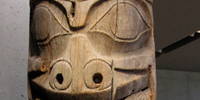 Back to Pacific NW Coast index
Back to Pacific NW Coast index
The First Nations of the Pacific Northwest
Mortuary Poles and Graves
The commonly used term Totem Pole refers to the tall cedar poles with multiple figures carved by Native people of the northern Northwest Coast. Several different types of monumental poles include: Mortuary poles made in the nineteenth century which housed the coffins of important people in a niche at the top; free standing memorial poles placed in front of houses to honour deceased chiefs; house frontal poles placed against the house front, often serving as doorways of houses; carved interior house posts that support roof beams. Carved of red cedar logs, the figures on totem poles are inherited crests, which identify the pole owners and tell their family histories.
Text above: http://www.burkemuseum.org/ethnology/faq_nwtotem
Mortuary Pole:
Particularly the Haida mortuary pole, had a cavity in the top which held the burial box inside which were the remains of a chief or high ranking person. These remains were placed in the box a year after the death. In order to accommodate the box, the cavity was generally cut into the wide end of the pole with the tapering end set into the ground. The box was hidden from view by a frontal board, painted and/or carved with a lineage crest, placed across the front. The shape and design of this board gave the appearance of a large chest.
Text above: http://www.sfu.ca/brc/art_architecture/totem_poles.html
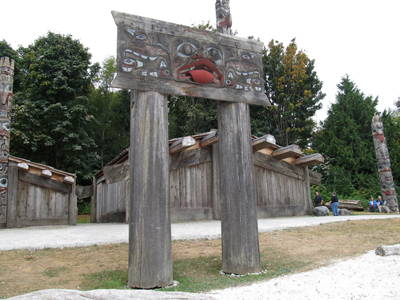
Dogfish Mortuary Pole
Carved by Bill Reid with assistant Doug Cranmer (Kwakwaka'wakw)
Totem Park, UBC, Vancouver, BC
ca 1961
Wood, polychrome
Collection of the UBC Museum of Anthropology
MOA #50032/b, 2115/4
Photo: Maria Hitchcock, 2012
Text: http://theravenscall.ca/en/who/life_story/middle_years
Source: Display, Museum of Anthropology, University of British Columbia
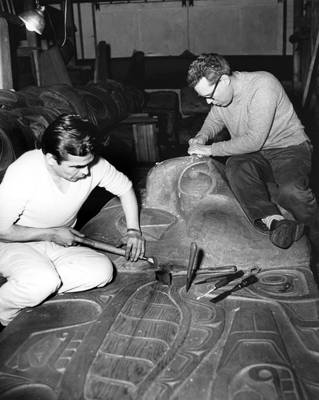
Dogfish Mortuary Pole
Bill Reid and Doug Cranmer carving the frontal board of the Haida Dogfish Mortuary Pole shown above.
Totem Park, UBC
Vancouver, BC
1961
UBC Historical Archives, UBC 3/3/1280
Text: http://theravenscall.ca/en/who/life_story/middle_years
Photo: http://vancouverartinthesixties.com/archive/119
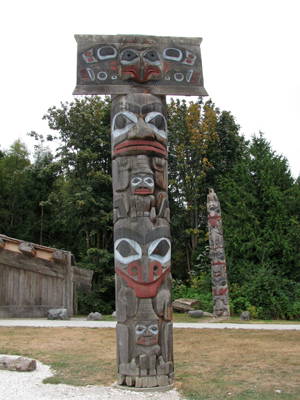
Haida Mortuary Pole
(from top to bottom)
Eagle
Human mother with child/cub
Grizzly Bear father with child/cub
Eagle designed by Bill Reid. Other figures adapted from older carvings inside museum: A50000d and A50002c
Carved by Bill Reid with Douglas Cranmer, 1960 - 1961
A50028
Photo: Don Hitchcock 2012
Source and text: Display, Museum of Anthropology, University of British Columbia
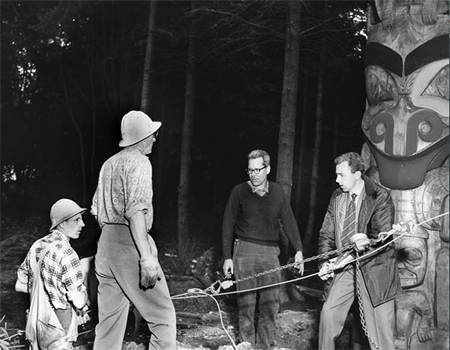
The erection of the totem pole above. Bill Reid at right centre.
Bill Reid and colleagues erecting a totem pole, Totem Park, UBC
1962
Photo: UBC Historical Archives, UBC 41.1/2108
(Note that either the pole has since been moved, or that many trees have been removed from the site - Don )
Source: http://theravenscall.ca/en/who
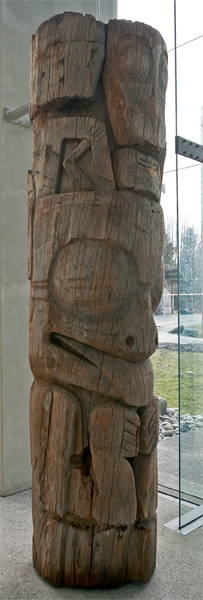
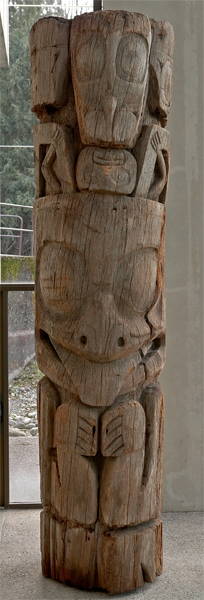
Mortuary Pole
Haida: Kunghit
A50017
Fragment: one base section of a mortuary pole; crescent-shaped in cross section and carved in shallow and deep relief. From the top down: top section of a killer whale facing downward; seated bear with small upside down human face between its ears and the human’s arms n the bear's ears. The bear has large eyes and protruding tongue; head of the bear is equal in size to its body. Pole is unpainted.
Stood outside a house which belonged to the lineage of 'Those Born at Songs of Victory Town' of the Raven Moiety of the Kunghit Haida.
Figures probably relate to crests owned by the lineage of the person whose remains were placed in the box on the pole.
Made in Ninstints, British Columbia, Canada and Skunggwai, British Columbia, Canada between 1800 and 1899
Collected by Wilson Duff, Michael Kew, Harry Hawthorn and Wayne Suttles between June 1957 and July 1957
Height 420 cm, width 110 cm, depth 100 cm
Condition: fair
Accession number: 2113/6
Photo and text: http://www.rrnpilot.org/items/17649
Source: Display, Museum of Anthropology, University of British Columbia
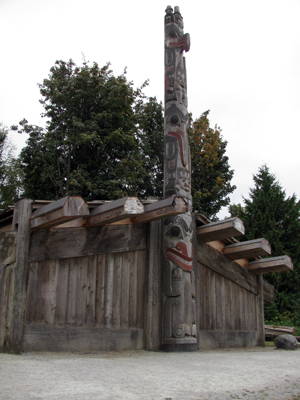
Haida Mortuary Pole
(Note that this pole has replaced an earlier pole in the same position, but is not described on the information boards in the park - Don )
Photo: Don Hitchcock 2012
Source: Display, Museum of Anthropology, University of British Columbia


This is the pole which was in this position. It has been moved inside the museum. My photo is composed of two photos stitched together in a vertical panorama.
Text below from Stewart (1993):
The focus of the museum's outdoor display is a large six-beam plank house, complete with house frontal pole - a replica of Haida dwellings of the late nineteenth century. Fronting the dwelling, which is made entirely of red cedar, is a tall, complex pole, its design inspired by a pole that once fronted a house at the south end of Skidegate on the Queen Charlotte Islands.
The asymmetrical tail flukes of Dogfish rise above three Watchmen, the central one of which is holding onto the domed head of Dogfish, whose dorsal fin forms the Watchman's nose. In its characteristic downturned mouth, dogflsh has a small Whale.
The next figure shows Frog protruding through the ears of Eagle, which is grasping Sculpin to its chest, holding in its claws the long spines that characterise sculpins.
At the base is Killer Whale, with a blowhole on its forehead; there is a man crouched above the upturned tail flukes, a combination that tells the Nanasimget story.
Photo (right): Don Hitchcock 2012
Photo (left) and text: Stewart (1993)
Double Post Mortuary
Consisted of two poles separated by a short distance. A boxlike construction of planks connected the two. Inside this structure there was space for two or three burial boxes of members of the same family.
Text above: http://www.sfu.ca/brc/art_architecture/totem_poles.html
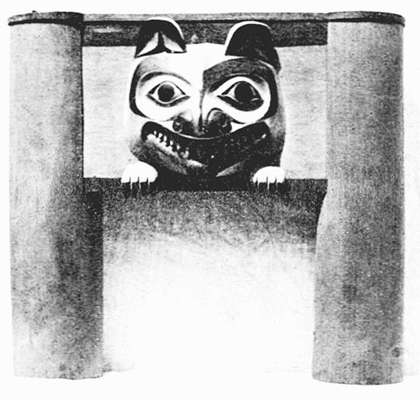
Haida Tomb
The two side-posts are solid and fixed in the ground. The horizontal piece is hollow, and contains the square box into which the corpse has been tightly packed.
Photo and text: Collison (1915)
Permission: Public Domain
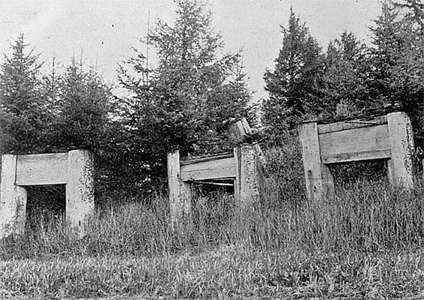
Haida Tombs at Massett, Queen Charlotte Islands, B.C. The side-posts are solid and sunk in the ground. The horizontal piece is hollow, and contains the corpse. These tombs are now falling through decay.
Photo and text: Collison (1915)
Permission: Public Domain
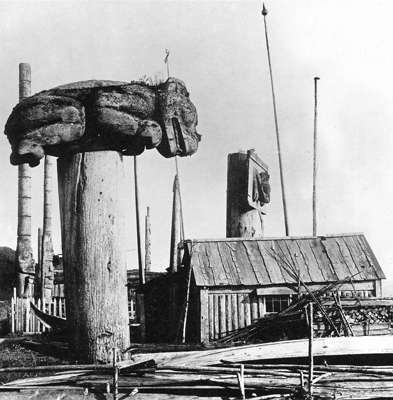
Bear Memorial
A memorial post consisting of a plain stout post about 3 metres high, surmounted by the large horizontal figure of a bear similar to, but much larger and more elaborately carved (including faces in the nostrils) than the bear (below) in front of Property House. Like the former, this may have been a mortuary figure with a receptacle in the side to receive a box of ashes or a child’s coffin.
(The carving was erected in memory of a chief of the Bear crest. This totem was standing in front of a chief's house at Massett, Queen Charlotte Islands in 1915, Collison (1915) )
Language Group: Haida
Village: Masset, Queen Charlotte Islands
Photo: G. Dorsey, 1897
Permission: Courtesy George MacDonald, Director, Bill Reid Centre for NWC Art Studies at Simon Fraser University, Vancouver, BC.
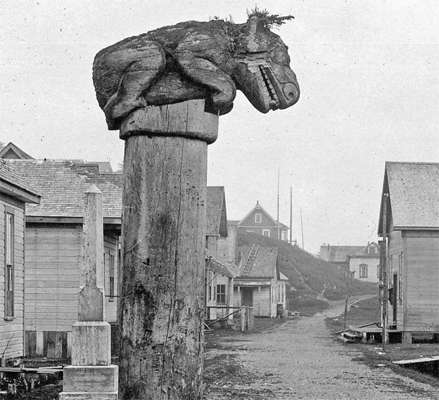
Bear Mortuary.
A large figure of a bear stands on top of a large post. It is almost identical to one at Kiutsta in which the bear is hollowed out to receive the bones of an infant. The Masset version was perhaps used only as a memorial post.
Directly behind the mortuary is a marble memorial for A.E. Edenshaw.
Language Group: Haida
Village: Masset, Queen Charlotte Islands
Photo: H.I. Smith, 1919
Permission: Courtesy George MacDonald, Director, Bill Reid Centre for NWC Art Studies at Simon Fraser University, Vancouver, BC.
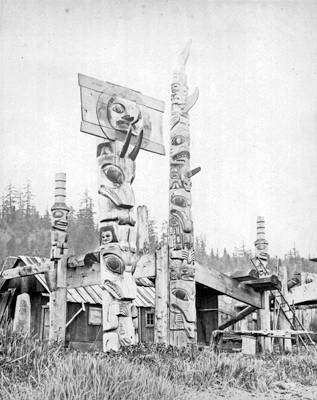
Indian village and chief's tomb - Queen Charlotte Island, between 1866 and 1870.
Photo: Frederick Dally
Donation: Tom Knott in 1973
Source: http://searcharchives.vancouver.ca/indian-village-and-chiefs-tomb-queen-charlotte-island;rad
Permission: Public Domain
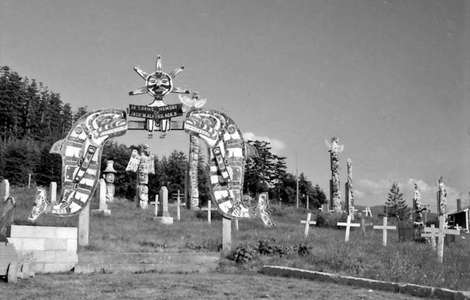
The Namgis Burial Grounds at Alert Bay is an old native cemetery and one of the few remaining locations on the BC coast where totems remain undisturbed on their original site. The grounds of the cemetery are now closed to the public, but the totem poles can be viewed from the roadside.
(note the mix of traditional totem poles interspersed with (presumably later) Christian crosses - Don )
Language Group: Kwakwaka'wakw
Photo: © Adelaide de Menil, 1967
Permission: Courtesy George MacDonald, Director, Bill Reid Centre for NWC Art Studies at Simon Fraser University, Vancouver, BC.
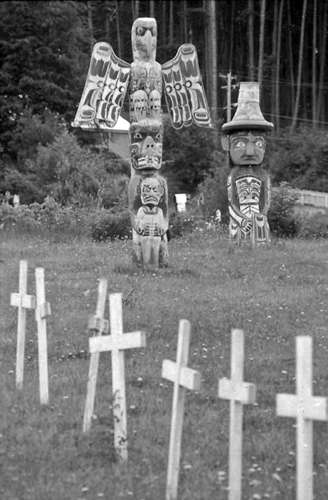
Totem Pole in the Namgis Burial Grounds at Alert Bay on Cormorant Island, with Christian crosses in the foreground.
Language Group: Kwakwaka'wakw
Photo: © Adelaide de Menil, 1968
Permission: Courtesy George MacDonald, Director, Bill Reid Centre for NWC Art Studies at Simon Fraser University, Vancouver, BC.
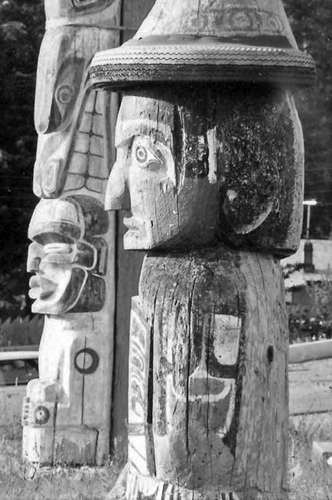
Close up of totem poles in the Namgis Burial Grounds at Alert Bay on Cormorant Island.
(Note the Dzunuk'wa figure, the wild woman of the woods, at the base of the totem pole in the background - Don )
Language Group: Kwakwaka'wakw
Photo: © Adelaide de Menil, 1967
Permission: Courtesy George MacDonald, Director, Bill Reid Centre for NWC Art Studies at Simon Fraser University, Vancouver, BC.
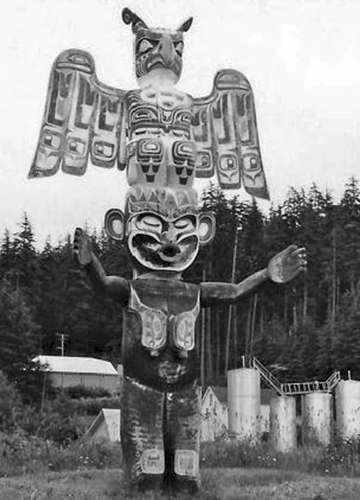
Totem Pole featuring Dzunuk'wa, the wild woman of the woods, surmounted by a Thunder Bird figure, in the Namgis Burial Grounds at Alert Bay on Cormorant Island.
Language Group: Kwakwaka'wakw
Photo: © Adelaide de Menil, 1968
Permission: Courtesy George MacDonald, Director, Bill Reid Centre for NWC Art Studies at Simon Fraser University, Vancouver, BC.
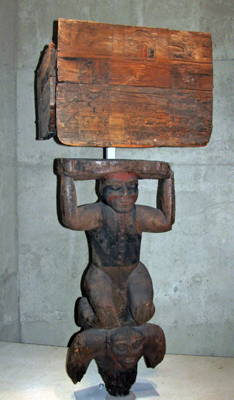
Memorial Sculpture: Tsartlip (West Saanich)
Central Coast Salish families held memorial services, like second funerals, a year or
more after the death of a loved one. At this time they often commissioned an
elaborately decorated casket or effigy to honour respected leaders. These memorials
were placed at family mortuary sites.
This memorial sculpture is both an effigy of the deceased and a casket. The monument
illustrates two distinctive Central Coast Salish sculptural styles: realistic sculpture in the
round (human figures); and highly stylized engraving on the surface of the box (fish).
When burial of the dead, rather than deposition in mortuary houses, became common
practice early in the 20th century, mortuary houses and memorial caskets were
disassembled and the remains of the dead interred in cemeteries. Tombstones are now
commissioned as memorials.
When it was no longer in use, this sculptured assemblage was purchased by Harlan I.
Smith for the National Museum of Man (now the Canadian Museum of Civilization in
Hull, Quebec) in 1929.
Canadian Museum of Civilization, VII-G-354 (a-g); artist unknown
Photo: Don Hitchcock 2012
Source: Display, Museum of Anthropology, University of British Columbia
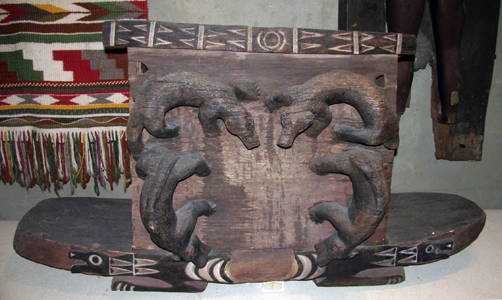
Family Memorial: Musqueam
This box is an outstanding example of the high relief sculptural style used by Central
Coast Salish artists to decorate grave boxes and mortuary houses in honour of
respected members of important families.
The engraving on the pedestal represents sillhqey, a two-headed snake that is
associated with spiritual power. On the front panel, in high relief, are four animals
identified as sxwamatsan, fishers. Effigies of these animals are featured in a ritual of
spiritual cleansing, a prestigious hereditary family privilege. Their representation here
proclaims the family's high status.
In earlier times Central Coast Salish people wrapped their dead in blankets, and placed
them in boxes or laid them to rest in family mortuary houses. In 1935 the owners of this
box dismantled their family mortuary house and grave boxes and interred the remains of
their members. The family sold the box to Harlan I. Smith for the National Museum of
Man (now the Canadian Museum of Civilization in Hull, Quebec). Proceeds from the
sale were used by the family to purchase a stone monument for a new gravesite in the
Musqueam cemetery. The box is currently on loan to the Museum of Anthropology.
This memorial is exhibited with approval of the Musqueam Indian Band.
Canadian Museum of Civilization, VII-G-359 (a-g); artist unknown.
Photo: Don Hitchcock 2012
Text: http://www.rrnpilot.org/
Source: Display, Museum of Anthropology, University of British Columbia
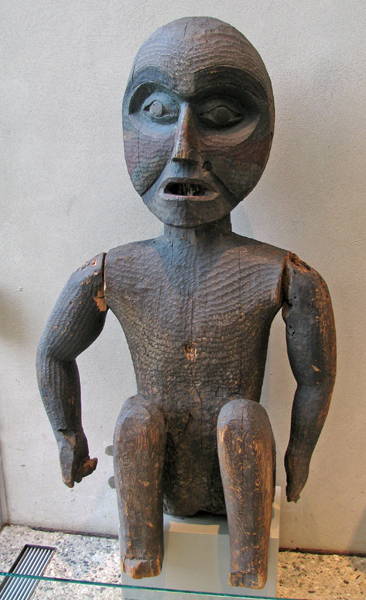
Ancestor Figure
Kwakwaka'wakw: 'Namgis
A1800
Carved wooden figure sitting with knees drawn up. The head is oval shaped with large ovoid eyes, protruding nose and open mouth. The upper lip and chin are painted black; a red band is painted across the face, the bridge of the nose and around the lips. Arms that hang down to the sides are attached separately to the body.
The figure represents Gumbegdles, a chief who found food for his tribe in a severe winter (G.H. Raley).
Made in Alert Bay, British Columbia, Canada and 'Yalis, British Columbia, Canada before 1894
Collected during 1894
Owned by George Henry Raley before November 1948
Received from H. R. MacMillan (Funding source) and George Henry Raley (Seller) during November 1948
Material: wood, paint and metal
Manufacturing Technique: carved, adzed, darkened and painted
Height 146 cm, width 83 cm, depth 36 cm
Condition: good
Accession number: 1960/199
Photo: Don Hitchcock 2012
text: http://www.rrnpilot.org/items/5075
Source: Display, Museum of Anthropology, University of British Columbia
Grave Figures
Coast Salish groups often placed the dead in grave houses built above ground. Wooden grave figures were placed outside these houses. Many depicted special privileges belonging to, and important qualities of, the person being remembered. This is one way family members commemorated the departed. The burning of personal possessions and offerings of food are another way that families continue to care for those who have passed on.
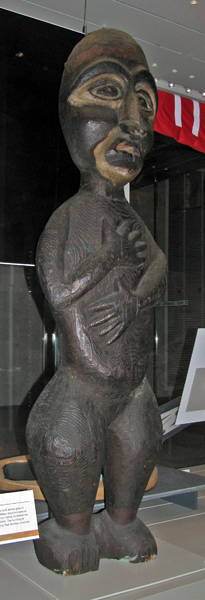
Human figure with exaggerated features standing upright. Right hand on breast and left hand on abdomen. Face carved in relief, wide downturned nose, open mouth, large deep eyes and heavy brows. Remnants of skin and hair on head nailed to head. Light brown paint around eyes, nose and jaw, also traces of white paint around mouth, nose and eyes. Formerly had hair and eyebrows of bear fur. Faint red band around forehead. Also strip of hairless skin on right groin.
In his description of Coast Salish grave figures, anthropologist, Paul S. Wingert notes that they: 'have long oval heads, thin columnar necks, and sloping shoulders. [They] also have tapering torsos, well marked groin lines, and similarly carved hands and fingers… [Facial features have] individualistic details [such as] high pointed nose and deep creases at the sides of the mouth and higher forehead and long broken nose (1949:42).'
The original purpose of the figure was unknown, since it was found in the Fraser River during a flood. However, given its stylistic attributes it may have been a grave figure.
Made before 1900
Collected in Sardis, British Columbia, Canada between 1893 and 1934
Owned by George Henry Raley before November 1948
Received from H. R. MacMillan (Funding source) and George Henry Raley (Seller) during November 1948
Identification Number: A1781
Material: skin, paint, cedar wood and metal
Manufacturing Technique: carved and painted
Height 1625 mm, width 475 mm, depth 240 mm
Condition: fair
Current location: Case 006
Accession number: 1960/186
Culture: Coast Salish: Sto:lo
Previous Owner: George Henry Raley
Received from: H. R. MacMillan (Funding source) and George Henry Raley (Seller)
Creation Date: before 1900
Photo: Don Hitchcock, 2012
Text: http://www.rrnpilot.org/items/5249
Source: Display, Museum of Anthropology, University of British Columbia
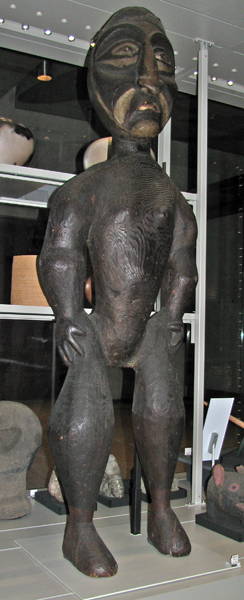
Figure with exaggerated features standing upright. Face carved in deep relief. Heavy brows, formerly had hair and eyebrows of bear fur. Some white paint left on chin and cheeks. Large deep eyes, wide downturned nose, opened mouth, and pronounced breasts. Remnants of strips of skin (hair lost) attached to forehead. Arms alongside body and hands on hips. Wide legs. Skin remnants also attached to the loins.
In his description of Coast Salish grave figures, anthropologist, Paul S. Wingert notes that they: 'have long oval heads, thin columnar necks, and sloping shoulders. [They] also have tapering torsos, well marked groin lines, and similarly carved hands and fingers… [Facial features have] individualistic details [such as] high pointed nose and deep creases at the sides of the mouth and higher forehead and long broken nose (1949:42).'
The purpose of the figure is unknown. It may have been a grave figure. It was found in the Fraser River during a flood.
Made before 1900
Collected in Sardis, British Columbia, Canada between 1893 and 1934
Owned by George Henry Raley before November 1948
Received from H. R. MacMillan (Funding source) and George Henry Raley (Seller) during November 1948
Identification Number: A1780
Material: paint, cat-tail grass, skin, cedar wood and metal
Manufacturing Technique: carved and painted
Height 1680 mm, width 555 mm, depth 390 mm
Condition: fair
Current location: Case 006
Accession number: 1960/185
Culture: Coast Salish: Sto:lo
Previous Owner: George Henry Raley
Received from: H. R. MacMillan (Funding source) and George Henry Raley (Seller)
Photo: Don Hitchcock, 2012
Text: http://www.rrnpilot.org/items/5278
Source: Display, Museum of Anthropology, University of British Columbia
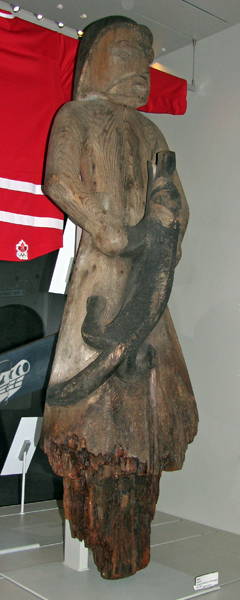
This is apparently a grave figure, and is also in case 006 with the other two figures above.
I have been unable to find it in the MOA archives.
Made of wood, with paint, it shows an apparently lightly bearded man holding a lizard like creature.
Photo: Don Hitchcock 2012
Source: Display, Museum of Anthropology, University of British Columbia
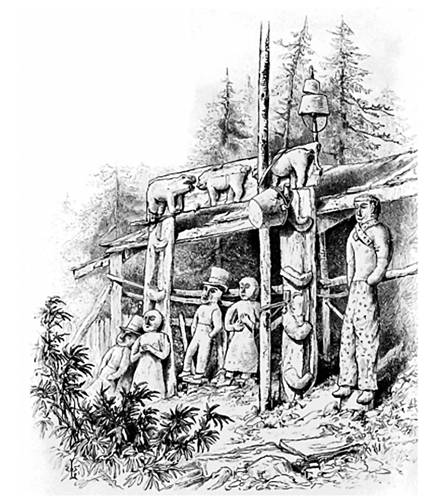
Salish graves, Chapman's Bar, British Columbia
Collection of Glenbow Museum NA-843-40
Photo: Engraved by Edward Whymper
Source: http://www.glenbow.org/media/coast_lp_grade_1-3.pdf
References
- Barbeau, M., 1950: Totem Poles, 2 Volumes, National Museum of Canada, Bulletin No. 119, Anthropological Series, No. 30, Ottawa: Department of The Secretary of State. 1950.
- Brown, P., 2011: We Are The Wuikinuxv Nation, UBC Museum of Anthropology Pacific Northwest sourcebook series © Wuikinuxv Nation UBC Museum of Anthropology, 2011 University of British Columbia 6393 N.W. Marine Drive Vancouver, B.C. V6T 1Z2
- Collison, W., 1915: In the Wake of the War Canoe, Toronto: Musson Book Company.
- Coull, C., 1996: A Traveller's Guide to Aboriginal B.C., Whitecap Books (April 1996)
- Duff, W., 1959: Histories, Territories and Laws of the Kitwancool, Anthropology in British Columbia Memoir No. 4 (Victoria: Provincial Museum of British Columbia, 1959)
- Galois, R., 1994: Kwakwaka'wakw Settlements, 1775-1920: A Geographical Analysis and Gazetteer, Volume 1 of Northwest native studies series, UBC Press, 1994
- Grant, P., 2001: Wish You Were Here: Life on Vancouver Island in Historical Postcards, Horsdal and Schubart
- Hawthorn, A., 1979: Kwakiutl Art, University of Washington Press (January 1, 1979)
- Jonaitis, A., 2006: Art of the Northwest Coast, University of Washington Press, October 1, 2006
- Martin, J., 2009: Making settler space - George Dawson, the Geological Survey of Canada and the Colonization of the Canadian West in the Late 19th Century , Ph D. thesis submitted to Queen's University Kingston, Ontario, Canada, September 2009
- Mayer, C., Shelton A., 2010: The Museum of Anthropology at the University of British Columbia, University of Washington Press, February 15, 2010
- Savard, D., 2005: Changing Images: Photographic Collections of First Peoples of the Pacific Northwest Coast Held in the Royal British Columbia Museum, 1860-1920BC Studies, no. 145, Spring 2005
- Stewart, H., 1993: Looking at Totem Poles, Douglas & McIntyre, Canada, 23 September 1993
Back to Don's Maps
 Back to Archaeological Sites
Back to Archaeological Sites
 Back to Pacific NW Coast index
Back to Pacific NW Coast index